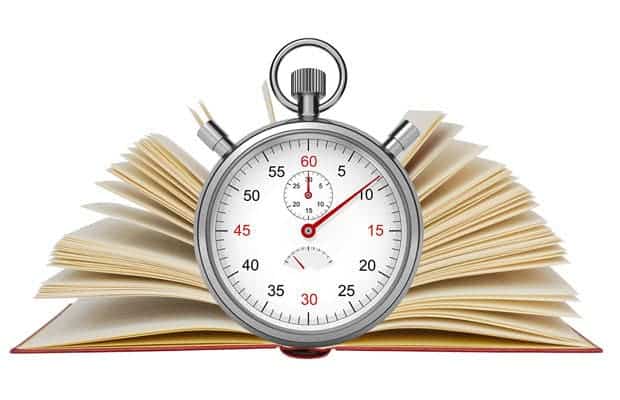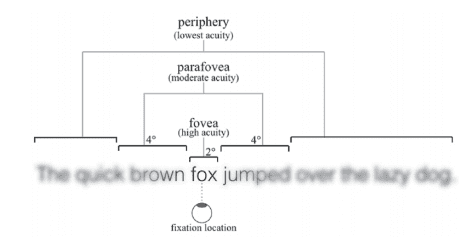What if you could read a book three times faster? That definitely sounds appealing, which is why speed-reading training and, most recently, apps are very popular. Research suggests, however, that for the most part speed-reading hurts comprehension. The best thing you can do to read faster, and still understand something, is to improve your language and vocabulary, scientists say.

According to Keith Rayner from the University of California, San Diego and colleagues who made a meta-analysis, there “is a trade-off between speed and accuracy”, and “it is unlikely that readers will be able to double or triple their reading speeds (eg from around 250 to 500–750 words per minute) while still being able to understand the text as well as if they read at normal speed”.
Some courses advertise that you’ll be able to read books like flipping through a phone book, or more than 2,000 words/minute which is anatomically impossible, Rayner says. Anything beyond 500 words/minute is improbable without drastically deteriorating comprehension. This limitation arises from the foveal viewing area — a small conical area of only about 1 degree or roughly the size of your thumb held at arm’s length.
The fovea is the small depression located in the exact centre of the macula that contains a high concentration of cones but no rods, and this is where our vision is most sharp. While the normal field of vision for each eye is about 135 degrees vertically and about 160 degrees horizontally, only the fovea has the ability to perceive and send clear, sharply focused visual images to the brain. In other words, anything outside the foveal viewing area is the peripheral vision.
This simple biological fact bluntly contradicts speed-reading courses that advertise you’ll be able to read in zig-zag or even vertically by the time you finish.
“[…] processing words out of order from the sensible sequence of the sentence … or when some of the words are removed … as would happen when a speed reader uses a zigzag movement – impairs the ability to process and understand the words,” the researchers write in their paper.

Another biological constraint deals with working memory or RAM, for you computer geeks. Scientists say that the brain can hold around 3 to 5 chunks of information at a time. This makes parsing multiple lines of text simultaneously impossible — for most people at least.
Most speed reading courses teach people to read the words off the page without imagining the corresponding sounds in their minds (called subvocalization). The researchers note, however, that “research on normal reading challenges this claim that the use of inner speech in silent reading is a bad habit”, because “there is evidence that inner speech plays an important role in word identification and comprehension during silent reading”.
The paper also examined the efficacy of speed-reading apps like Spritz. Unlike speed courses that advise reading in saccades, Spritz works by feeding text one word a time at a given rate which increases with your confidence and training. Each word appears in the same place on the screen, so your eye can stay fixed on that point while words flip through more quickly than you could hunt them down on a page. Indeed, at first glance, it sounds like this will help you read faster and it will, but again not without sacrificing comprehension. However, it’s exactly that time “lost” finding words that is essential to understanding a text. In the fractions of a second that we spend moving to the next word or line the brain is hard at work processing the meaning of all those words.
Apps like these don’t let you skip back, so essentially you might be turning a good book or article into a sprint with little to show but sore eyes at the end.
The average reader snails through prose at a rate of about 250-300 words per minute, which roughly equates to about one page per minute. Previously, researchers discovered that as these readers crested 600 words per minute, comprehension invariably dove below 75%. Which is not to say that people who read more than 600 wpm and still can retain what they’ve read aren’t for real — they’re just a lot fewer than you’d think.
In the World Championship Speed Reading Competition, the top contestants typically read around 1,000 to 2,000 words per minute. Six-times World Speed Reading Champion, Anne Jones, who last summer read Harper Lee’s Go Set a Watchman in 25 minutes, 31 seconds is not convinced by the findings.
“For events, I train just like an athlete does. Of course, PR people want me to read as fast as I can for events such as last July’s Go Set a Watchman. That was an outstanding reading performance. I read the book, understood it, loved it and talked about it in depth to lots of journalists immediately afterwards. Because it looked effortless does not mean it was easy to do. I have 20 years’ experience of speed reading and I know exactly how to approach a reading task such as that,” she said for The Guardian.
You could double your reading speed up to the upper bound (600 wpm), and some speed reading techniques might help like holding a pen or some other pointer as cursor so your eyes don’t wander off. Depending on what you have to read, skimming and zig-zagging might work too. If the text is a bit more complex, though, it doesn’t seem to be worth it. The biggest jump in reading speed might be no secret at all: pure hard work. Read a lot, practice your vocabulary and you might learn to read a lot faster than you currently are.”Slow and steady wins the race”.



